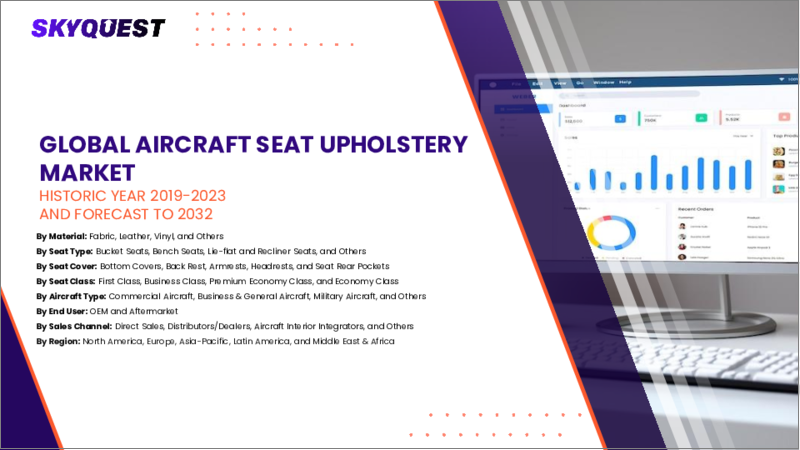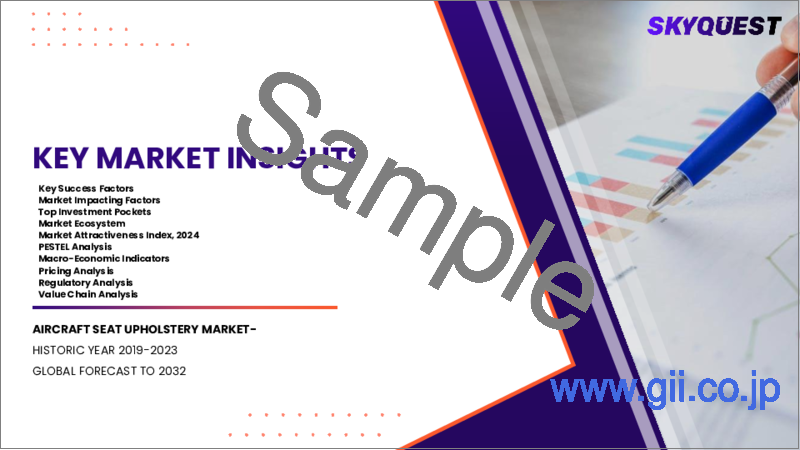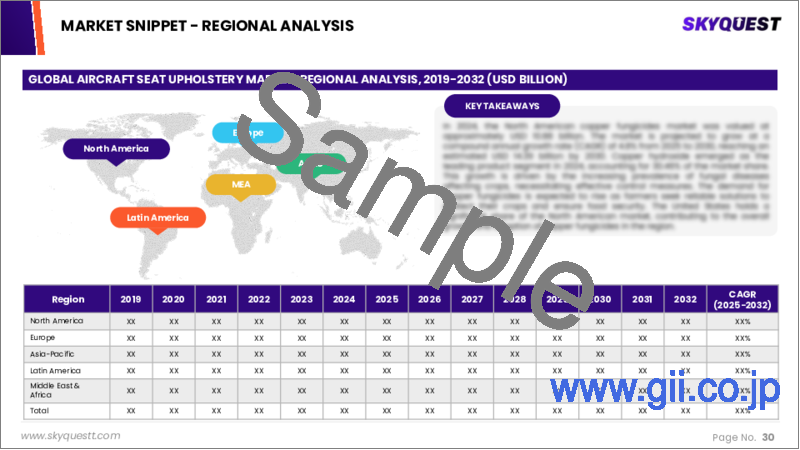|
|
市場調査レポート
商品コード
1622412
航空機シート表皮市場規模、シェア、成長分析、素材別、シートカバー別、シートタイプ別、航空機タイプ別、エンドユーザー別、地域別 - 産業予測、2025~2032年Aircraft Seat Upholstery Market Size, Share, Growth Analysis, By Material (Fabric, Leather), By Seat Cover (Bottom Covers, Back Rest), By Seat Type, By Aircraft Type, By End User, By Region - Industry Forecast 2025-2032 |
||||||
|
|||||||
| 航空機シート表皮市場規模、シェア、成長分析、素材別、シートカバー別、シートタイプ別、航空機タイプ別、エンドユーザー別、地域別 - 産業予測、2025~2032年 |
|
出版日: 2024年12月21日
発行: SkyQuest
ページ情報: 英文 157 Pages
納期: 3~5営業日
|
全表示
- 概要
- 目次
航空機シート表皮の世界市場規模は2023年に18億米ドルと評価され、2024年の18億6,000万米ドルから2032年には24億5,000万米ドルに成長し、予測期間(2025-2032年)のCAGRは3.5%で成長する見通しです。
世界の航空機シート表皮市場は、航空旅行の増加と乗客の快適さへの要求の高まりによって、力強い成長を遂げています。航空会社は、快適で耐久性に優れ、視覚的にも魅力的な高品質の椅子張り生地への投資価値をますます認識し、旅行体験を向上させています。同市場では、多様な航空機タイプや顧客の嗜好に対応するため、皮革、布地、合成繊維など、さまざまな素材が使用されています。技術の進歩により、軽量、耐火性、環境に優しい椅子張りソリューションが生み出され、市場拡大に寄与しています。さらに、メンテナンスコストの削減とシート寿命の延長に重点を置くことで、優れた椅子張り生地への需要が高まっています。航空各社が差別化を図るために革新的なシート設計に取り組んでおり、競争が激化する中でアジア太平洋地域が重要な成長市場として浮上しています。全体として、この市場は、絶え間ない進歩と乗客の快適性への取り組みによって繁栄しています。
目次
イントロダクション
- 調査の目的
- 調査範囲
- 定義
調査手法
- 情報調達
- 二次データと一次データの方法
- 市場規模予測
- 市場の前提条件と制限
エグゼクティブサマリー
- 世界市場の見通し
- 供給と需要の動向分析
- セグメント別機会分析
市場力学と見通し
- 市場概要
- 市場規模
- 市場力学
- 促進要因と機会
- 抑制要因と課題
- ポーターの分析
主な市場の考察
- 重要成功要因
- 競合の程度
- 主な投資機会
- 市場エコシステム
- 市場の魅力指数(2024年)
- PESTEL分析
- マクロ経済指標
- バリューチェーン分析
- 価格分析
- 規制分析
- ケーススタディ分析
- 貿易分析
航空機シート表皮市場規模:素材別
- 市場概要
- ファブリック
- 天然素材
- ポリエステル
- ウール/ナイロン混紡
- レザー
- 本革
- 合成皮革
- ビニール
航空機シート表皮市場規模:シートカバー別
- 市場概要
- ボトムカバー
- バックレスト
- アームレスト
- ヘッドレスト
- シート後部ポケット
航空機シート表皮市場規模:シートタイプ別
- 市場概要
- ファーストクラス
- ビジネスクラス
- プレミアムエコノミークラス
- エコノミークラス
航空機シート表皮市場規模:航空機タイプ別
- 市場概要
- ナローボディ機
- ワイドボディ機
- 地域輸送機
- ビジネスジェット
航空機シート表皮市場規模:エンドユーザー別
- 市場概要
- OEM
- アフターマーケット
航空機シート表皮市場規模
- 北米
- 米国
- カナダ
- 欧州
- ドイツ
- スペイン
- フランス
- 英国
- イタリア
- その他欧州地域
- アジア太平洋地域
- 中国
- インド
- 日本
- 韓国
- その他アジア太平洋地域
- ラテンアメリカ
- ブラジル
- その他ラテンアメリカ地域
- 中東・アフリカ
- GCC諸国
- 南アフリカ
- その他中東・アフリカ
競合情報
- 上位5社の比較
- 主要企業の市場ポジショニング(2024年)
- 主な市場企業が採用した戦略
- 市場の最近の動向
- 企業の市場シェア分析(2024年)
- 主要企業の企業プロファイル
- 会社概要
- 製品ポートフォリオ分析
- セグメント別シェア分析
- 収益の前年比比較(2022-2024)
主要企業プロファイル
- Tritex Corporation(US)
- ACC Interiors(US)
- Tapis Corp(US)
- International Aero Services(US)
- Lantal Textiles AG(Switzerland)
- Franklin Products(US)
- OmnAvia Interiors(US)
- Spectra Interior Products(US)
- Aircraft Interior Products(US)
- Douglas Interior Products(US)
- Aviointeriors S.p.A(Italy)
- Botany Weaving(Australia)
- Mohawk Group(US)
- Interface, Inc.(US)
- Sobel Westex(US)
- Kontec Group(Canada)
- Fenice Care System S.p.A(Italy)
- Inflight Canada Inc.(Canada)
- Aerofoam Industries(US)
- Turn-Key Processing Solutions(US)
結論と推奨事項
Global Aircraft Seat Upholstery Market size was valued at USD 1.8 billion in 2023 and is poised to grow from USD 1.86 billion in 2024 to USD 2.45 billion by 2032, growing at a CAGR of 3.5% during the forecast period (2025-2032).
The global aircraft seat upholstery market is experiencing robust growth, driven by rising air travel and heightened passenger comfort demands. Airlines increasingly recognize the value of investing in quality upholstery-comfortable, durable, and visually appealing-to enhance the travel experience. The market showcases a variety of materials, including leather, fabric, and synthetic options to meet diverse aircraft types and customer preferences. Technological advancements have led to the creation of lightweight, fire-resistant, and eco-friendly upholstery solutions, contributing to market expansion. Additionally, the focus on reducing maintenance costs and prolonging seat lifespan has boosted demand for superior upholstery. With airlines striving for innovative seat designs to differentiate themselves, the Asia-Pacific region emerges as a significant growth market amid rising competition. Overall, this market is thriving, marked by continuous advancements and a commitment to passenger comfort.
Top-down and bottom-up approaches were used to estimate and validate the size of the Global Aircraft Seat Upholstery market and to estimate the size of various other dependent submarkets. The research methodology used to estimate the market size includes the following details: The key players in the market were identified through secondary research, and their market shares in the respective regions were determined through primary and secondary research. This entire procedure includes the study of the annual and financial reports of the top market players and extensive interviews for key insights from industry leaders such as CEOs, VPs, directors, and marketing executives. All percentage shares split, and breakdowns were determined using secondary sources and verified through Primary sources. All possible parameters that affect the markets covered in this research study have been accounted for, viewed in extensive detail, verified through primary research, and analyzed to get the final quantitative and qualitative data.
Global Aircraft Seat Upholstery Market Segmental Analysis
Global Aircraft Seat Upholstery Market is segmented by material, seat cover, seat type, aircraft type, end user and region. Based on material, the market is segmented into fabric, leather and vinyl. Based on seat cover, the market is segmented into bottom covers, back rest, armrests, headrests and seat rear pockets. Based on seat type, the market is segmented into first class, business class, premium economy class and economy class. Based on aircraft type, the market is segmented into narrow-body aircraft, wide-body aircraft, regional transport aircraft and business jets. Based on end user, the market is segmented into OEM and aftermarket. Based on region, the market is segmented into North America, Europe, Asia Pacific, Latin America and Middle East & Africa.
Driver of the Global Aircraft Seat Upholstery Market
A significant factor propelling the global aircraft seat upholstery market is the ongoing rise in air passenger traffic. As air travel becomes more affordable and accessible to an expanding demographic, coupled with the growth of global tourism, airlines are under increasing pressure to deliver superior comfort and experience for their passengers. This heightened demand necessitates the production of seat upholstery that is not only comfortable and durable but also visually appealing, thereby driving the market's growth. As airlines strive to meet these elevated expectations, the need for premium aircraft seat upholstery continues to surge, ultimately fostering a more competitive market environment.
Restraints in the Global Aircraft Seat Upholstery Market
A significant constraint affecting the global aircraft seat upholstery market is the instability of raw material prices. Prices for essential upholstery materials, including leather, fabric, and synthetic options, can vary greatly due to factors like supply chain interruptions, shifts in market demand, and geopolitical issues. This price volatility creates challenges for upholstery manufacturers and airlines as they navigate budgeting and pricing strategies. Such unpredictability can hinder profitability and complicate decision-making processes within the industry. Consequently, the fluctuations in raw material costs can threaten the overall stability and growth potential of the aircraft seat upholstery market.
Market Trends of the Global Aircraft Seat Upholstery Market
A prominent trend shaping the global aircraft seat upholstery market is the rising commitment to sustainability and the use of eco-friendly materials. As airlines and manufacturers strive to address environmental concerns, there is a concerted push towards integrating sustainable materials in seat upholstery, such as recycled fabrics and bio-based polymers. This shift aligns with broader efforts to reduce the aviation sector's carbon footprint while delivering enhanced passenger comfort. Innovations in upholstery design not only reflect a dedication to eco-consciousness but also cater to the growing consumer preference for environmentally responsible travel options, signaling a transformative phase in the industry.
Table of Contents
Introduction
- Objectives of the Study
- Scope of the Report
- Definitions
Research Methodology
- Information Procurement
- Secondary & Primary Data Methods
- Market Size Estimation
- Market Assumptions & Limitations
Executive Summary
- Global Market Outlook
- Supply & Demand Trend Analysis
- Segmental Opportunity Analysis
Market Dynamics & Outlook
- Market Overview
- Market Size
- Market Dynamics
- Drivers & Opportunities
- Restraints & Challenges
- Porters Analysis
- Competitive rivalry
- Threat of substitute
- Bargaining power of buyers
- Threat of new entrants
- Bargaining power of suppliers
Key Market Insights
- Key Success Factors
- Degree of Competition
- Top Investment Pockets
- Market Ecosystem
- Market Attractiveness Index, 2024
- PESTEL Analysis
- Macro-Economic Indicators
- Value Chain Analysis
- Pricing Analysis
- Regulatory Analysis
- Case Study Analysis
- Trade Analysis
Global Aircraft Seat Upholstery Market Size by Material & CAGR (2025-2032)
- Market Overview
- Fabric
- Natural Fabric
- Polyester
- Wool/Nylon Blend
- Leather
- Genuine Leather
- Synthetic/Artificial Leather
- Vinyl
Global Aircraft Seat Upholstery Market Size by Seat Cover & CAGR (2025-2032)
- Market Overview
- Bottom Covers
- Back Rest
- Armrests
- Headrests
- Seat Rear Pockets
Global Aircraft Seat Upholstery Market Size by Seat Type & CAGR (2025-2032)
- Market Overview
- First Class
- Business Class
- Premium Economy Class
- Economy Class
Global Aircraft Seat Upholstery Market Size by Aircraft Type & CAGR (2025-2032)
- Market Overview
- Narrow-Body Aircraft
- Wide-Body Aircraft
- Regional Transport Aircraft
- Business Jets
Global Aircraft Seat Upholstery Market Size by End User & CAGR (2025-2032)
- Market Overview
- OEM
- Aftermarket
Global Aircraft Seat Upholstery Market Size & CAGR (2025-2032)
- North America (Material, Seat Cover, Seat Type, Aircraft Type, End User)
- US
- Canada
- Europe (Material, Seat Cover, Seat Type, Aircraft Type, End User)
- Germany
- Spain
- France
- UK
- Italy
- Rest of Europe
- Asia Pacific (Material, Seat Cover, Seat Type, Aircraft Type, End User)
- China
- India
- Japan
- South Korea
- Rest of Asia-Pacific
- Latin America (Material, Seat Cover, Seat Type, Aircraft Type, End User)
- Brazil
- Rest of Latin America
- Middle East & Africa (Material, Seat Cover, Seat Type, Aircraft Type, End User)
- GCC Countries
- South Africa
- Rest of Middle East & Africa
Competitive Intelligence
- Top 5 Player Comparison
- Market Positioning of Key Players, 2024
- Strategies Adopted by Key Market Players
- Recent Developments in the Market
- Company Market Share Analysis, 2024
- Company Profiles of All Key Players
- Company Details
- Product Portfolio Analysis
- Company's Segmental Share Analysis
- Revenue Y-O-Y Comparison (2022-2024)
Key Company Profiles
- Tritex Corporation (US)
- Company Overview
- Business Segment Overview
- Financial Updates
- Key Developments
- ACC Interiors (US)
- Company Overview
- Business Segment Overview
- Financial Updates
- Key Developments
- Tapis Corp (US)
- Company Overview
- Business Segment Overview
- Financial Updates
- Key Developments
- International Aero Services (US)
- Company Overview
- Business Segment Overview
- Financial Updates
- Key Developments
- Lantal Textiles AG (Switzerland)
- Company Overview
- Business Segment Overview
- Financial Updates
- Key Developments
- Franklin Products (US)
- Company Overview
- Business Segment Overview
- Financial Updates
- Key Developments
- OmnAvia Interiors (US)
- Company Overview
- Business Segment Overview
- Financial Updates
- Key Developments
- Spectra Interior Products (US)
- Company Overview
- Business Segment Overview
- Financial Updates
- Key Developments
- Aircraft Interior Products (US)
- Company Overview
- Business Segment Overview
- Financial Updates
- Key Developments
- Douglas Interior Products (US)
- Company Overview
- Business Segment Overview
- Financial Updates
- Key Developments
- Aviointeriors S.p.A (Italy)
- Company Overview
- Business Segment Overview
- Financial Updates
- Key Developments
- Botany Weaving (Australia)
- Company Overview
- Business Segment Overview
- Financial Updates
- Key Developments
- Mohawk Group (US)
- Company Overview
- Business Segment Overview
- Financial Updates
- Key Developments
- Interface, Inc. (US)
- Company Overview
- Business Segment Overview
- Financial Updates
- Key Developments
- Sobel Westex (US)
- Company Overview
- Business Segment Overview
- Financial Updates
- Key Developments
- Kontec Group (Canada)
- Company Overview
- Business Segment Overview
- Financial Updates
- Key Developments
- Fenice Care System S.p.A (Italy)
- Company Overview
- Business Segment Overview
- Financial Updates
- Key Developments
- Inflight Canada Inc. (Canada)
- Company Overview
- Business Segment Overview
- Financial Updates
- Key Developments
- Aerofoam Industries (US)
- Company Overview
- Business Segment Overview
- Financial Updates
- Key Developments
- Turn-Key Processing Solutions (US)
- Company Overview
- Business Segment Overview
- Financial Updates
- Key Developments






